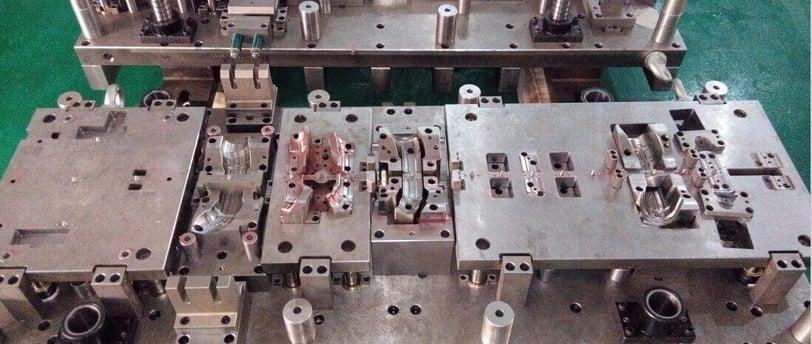Advantages of Stamping Dies vs. Traditional Processing Methods
1/23/2025


Introduction to Stamping Dies
Stamping dies are specialized tools utilized in the manufacturing process to shape metal and other materials into desired forms and designs. These dies play a crucial role in various industries, including automotive, aerospace, and electronics, where precision and consistency are paramount. Stamping generally involves using a stamping press to depress the die into a material, thereby forming it into a specific shape. This method is known for its efficiency and the high-volume production capabilities it offers.
Typically, stamping dies are made from durable materials such as tool steel, which is capable of withstanding the significant forces exerted during the stamping process. The types of materials suited for stamping are diverse and can include metals like steel, aluminum, and copper, as well as various plastics and composites. The choice of material often depends on the application requirements and the properties needed in the final product.
The basic principles behind stamping involve a few key processes: blanking, punching, bending, and forming. In blanking, a flat sheet of material is cut into specific shapes. Punching refers to creating holes within the material, while bending allows for the manipulation of the workpiece into curved or angled forms. Forming is a more complex process that results in a three-dimensional shape. This systematic approach ensures high precision and repeatability, which is essential for maintaining quality in large-scale production.
The significance of stamping dies in modern manufacturing cannot be overstated. As industries increasingly demand higher production rates and lower costs, stamping becomes an attractive alternative to traditional processing methods. This advancement underscores the importance of stamping technologies in contemporary manufacturing, paving the way for a robust comparison with more conventional techniques.
Cost-Effectiveness of Stamping Dies
Stamping dies represent an innovative approach in manufacturing that offers considerable cost advantages over traditional processing methods. The initial setup costs associated with stamping dies can vary depending on complexity and materials, however, once established, they often prove to be financially viable over time. Unlike processes such as machining or manual fabrication, stamping dies allow for mass production with minimal adjustments needed after the setup phase. This leads to a dramatic increase in production efficiency, allowing manufacturers to produce large quantities of parts in a shorter duration.
Furthermore, the efficiency of stamping dies translates to reduced labor costs. Traditional methods often require skilled labor to operate machines, monitor production, and perform adjustments. In contrast, stamping die operations can be automated, requiring less oversight and resulting in lower labor costs per unit produced. The reduced dependency on highly skilled workers can alleviate hiring challenges while simultaneously decreasing payroll obligations.
Another significant factor in the cost-effectiveness of stamping dies is material waste reduction. Traditional methods, like cutting or machining, can lead to significant material loss due to the machining process itself, including scrap and detritus. However, stamping dies maximize material usage by often requiring only what is necessary for production with minimal waste. This efficient use of materials not only reduces costs but also contributes to sustainable practices by generating less scrap metal.
Real-world examples further illustrate the economic benefits of using stamping dies. For instance, a study conducted in the automotive industry demonstrated that manufacturers utilizing stamping dies reduced costs by up to 30% when compared to traditional fabrication methods. This efficiency is attributed to faster cycle times and reduced material wastage, showcasing stamping dies as a smart choice for long-term financial savings in various industries.
Quality and Precision of Stamping
Stamping dies are known for their ability to produce high-quality components with remarkable precision, a feat that distinguishes them from traditional processing methods. One of the primary factors contributing to this superior quality is dimensional accuracy. Stamping allows for the creation of parts with tight tolerances, which are essential in industries where precision is paramount, such as automotive and aerospace manufacturing. The use of high-quality materials and robust die construction ensures that each stamped part maintains its intended specifications, reducing the need for post-processing and rework.
Another critical aspect of quality in stamping is surface finish. Stamped components tend to exhibit a finer surface finish compared to those produced by traditional methods like machining or casting. This is largely due to the high pressures applied during the stamping process, which compresses the material and can minimize imperfections. A better surface finish not only enhances the aesthetic appeal of the components but also improves their functional performance, particularly in applications where friction and wear resistance are important.
Repeatability is another significant advantage of stamping dies. Once a stamping die is created and calibrated, it can produce the same part consistently over thousands of cycles. This repeatability is advantageous for production runs where uniformity is crucial. Traditional processing methods, on the other hand, often rely on manual adjustments and operator skill, which can lead to variations in product quality.
Recent technological advancements have further enhanced the quality and precision of stamping. Innovations such as computer-aided design (CAD) and computer numerical control (CNC) systems have streamlined die design, allowing for more complex geometries and tighter tolerances. Additionally, improvements in materials used for stamping dies, such as advanced alloys, have resulted in longer tool life and reduced downtime. These advancements collectively contribute to elevating the quality and precision in manufacturing through stamping dies.
Versatility and Production Speed of Stamping Dies
Stamping dies offer a remarkable range of versatility that distinguishes them from traditional processing methods. The ability to create both simple and complex shapes makes stamping an invaluable technique across various industries. Stamping dies can accommodate intricate designs, allowing for detailed features that may be challenging or impractical to achieve through machining, casting, or other traditional fabrication methods. This adaptability is critical in today's fast-paced industrial environments, where manufacturers require solutions that cater to diverse product specifications while maintaining high levels of precision.
In addition to versatility, the production speed associated with stamping die processes is a significant advantage. Stamping can produce components at a much faster rate than traditional methods, which often necessitate longer setup times and more labor-intensive processes. For instance, within the automotive industry, stamping techniques are employed for producing everything from body panels to intricate engine components. The rapid production capabilities of stamping dies streamline the manufacturing process and allow companies to meet tight deadlines and fluctuating market demands without sacrificing quality.
Furthermore, the quick turnaround times facilitated by stamping die technology enable manufacturers to pivot efficiently in response to changing consumer preferences. This flexibility is essential in a competitive market, where adapting to trends can dictate the success of a product. Case studies across various sectors, such as electronics and consumer goods, have demonstrated how businesses utilizing stamping technologies can respond to shifts in demand more swiftly than competitors relying on traditional methods. Overall, the integration of stamping dies into manufacturing processes enhances operational efficiency, enabling companies to deliver high-quality products promptly while remaining versatile in their applications.
